
This week's range was about two percent with swings on Wednesday and Thursday, but in the end the market was hardly changed at all. So much for Santa Claus.
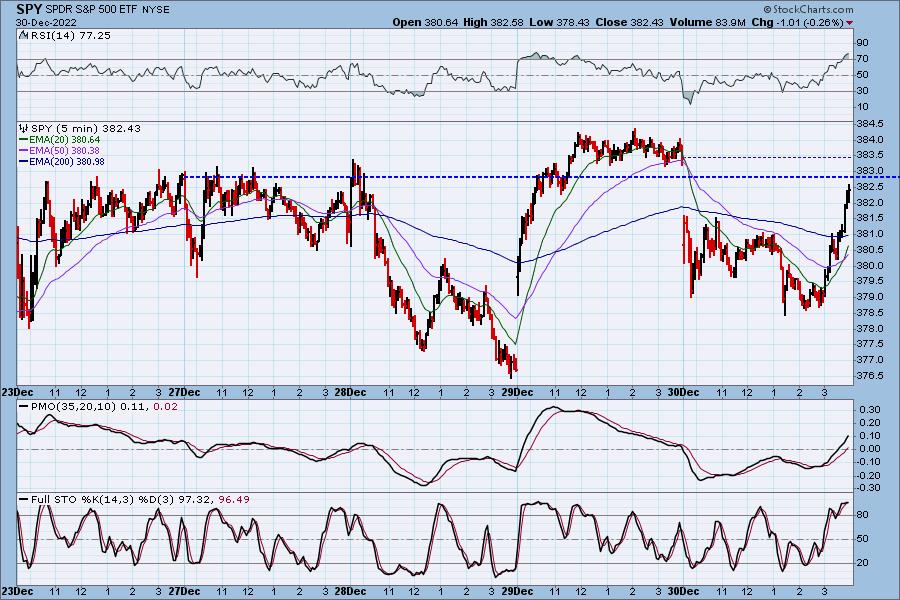
_____
Regarding the Put/Call Ratio article yesterday, Carl intended to mention another important feature on the chart. While the Put/Call Ratios are making all-time highs, the market (SPY) is making a higher low (versus the October low), forming a reverse divergence, which in this case is bullish. So, while the Put/Call Ratios were showing maximum bearish sentiment, which is bullish, the reverse divergence compounds the bullish implications of negative sentiment. Further, checking the 21 market and sector indexes we track, only the Consumer Discretionary Sector has confirmed the extreme Put/Call Ratio reading with a lower price low. The Nasdaq Composite and Nasdaq 100 found support at the October low, and the rest have higher lows, like the S&P 500. This positive element contradicts the bearish argument, but, remember, the Put/Call Ratio could continue making more extreme readings, and prices could ultimately take out the October lows. But at this point we can't ignore the positive aspects of this chart.

The DecisionPoint Alert Weekly Wrap presents an end-of-week assessment of the trend and condition of the Stock Market, the U.S. Dollar, Gold, Crude Oil, and Bonds. The DecisionPoint Alert daily report (Monday through Thursday) is abbreviated and gives updates on the Weekly Wrap assessments.
Watch the latest episode of DecisionPoint on StockCharts TV's YouTube channel here!
MAJOR MARKET INDEXES
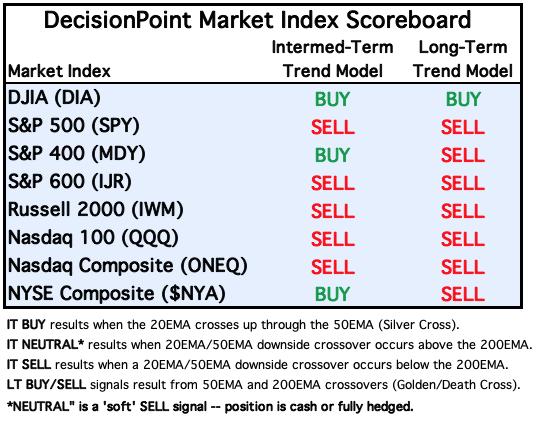
For Today: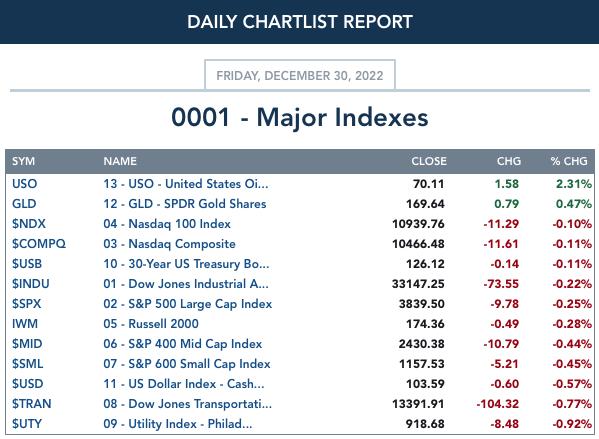
For the Week:
SECTORS
Each S&P 500 Index component stock is assigned to one of 11 major sectors. This is a snapshot of the Intermediate-Term (Silver Cross) and Long-Term (Golden Cross) Trend Model signal status for those sectors.

For Today: 
For the Week:
CLICK HERE for Carl's annotated Sector charts.
THE MARKET (S&P 500)
IT Trend Model: SELL as of 12/28/2022
LT Trend Model: SELL as of 5/5/2022
SPY Daily Chart: We have now spotted a pennant on a flag pole. This is a bearish pattern and suggests that price will break lower not higher.
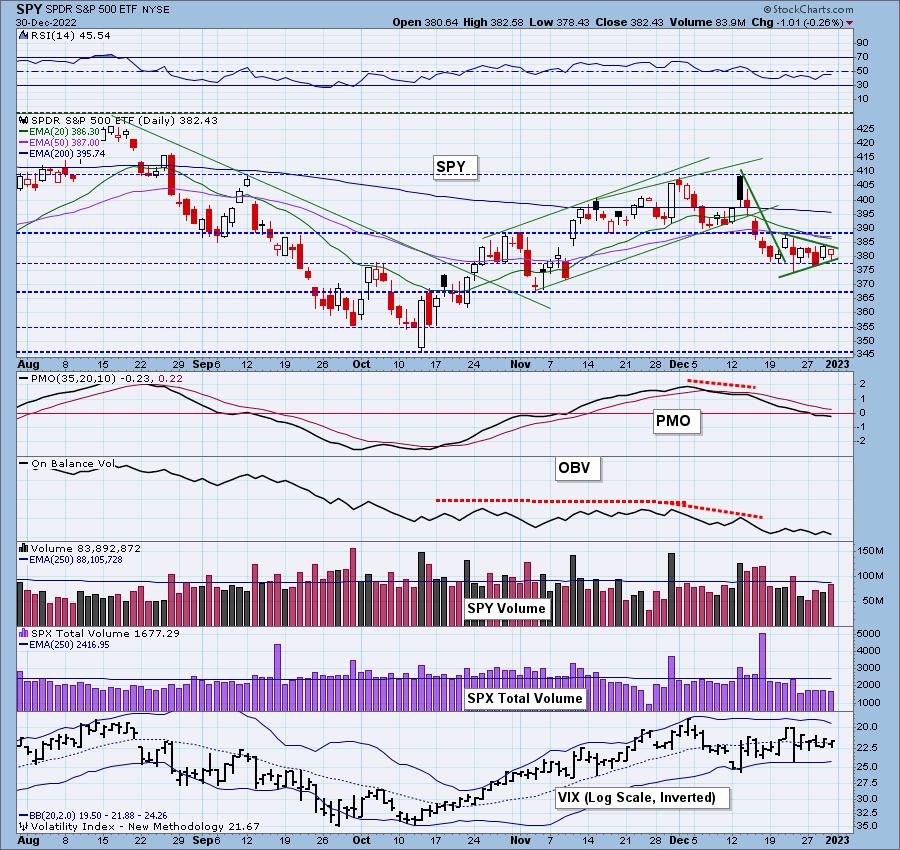
The RSI has topped in negative territory below net neutral (50). The PMO continues lower below the zero line. Stochastics did turn up, but remain weak below 20. The VIX is no help at all as it hovers around its moving average.
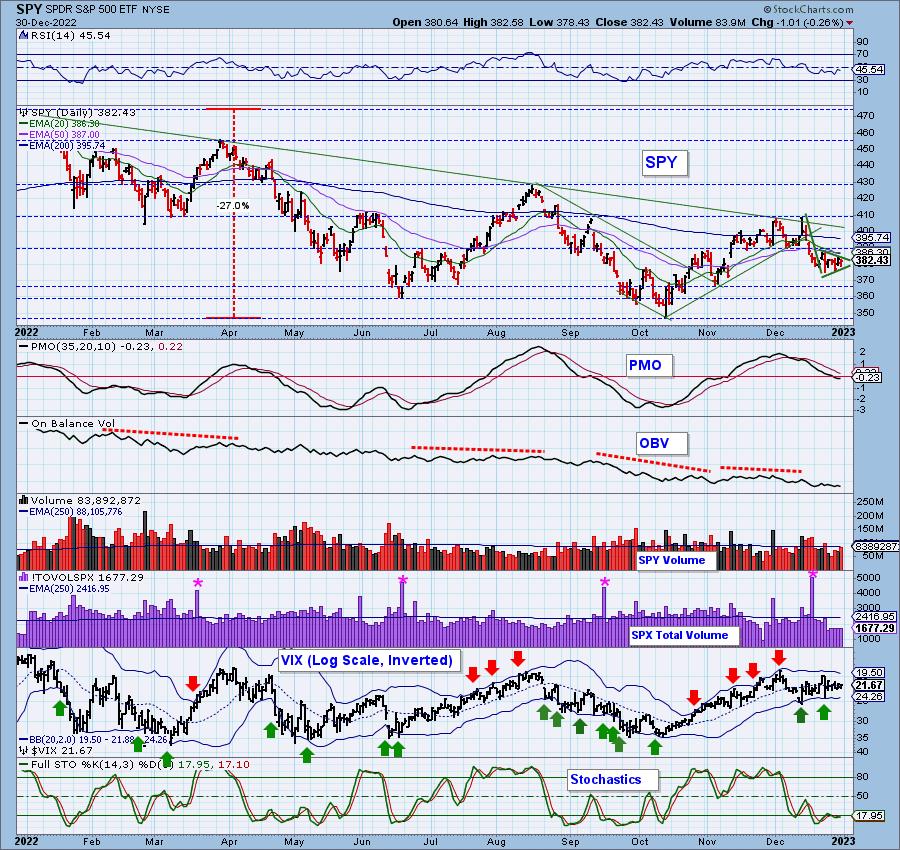
Here is a copy of our last recording:
SPY Weekly Chart: After an unsuccessful breakout from the long-term declining trend, price continues lower. The weekly PMO has topped and the weekly RSI is negative.
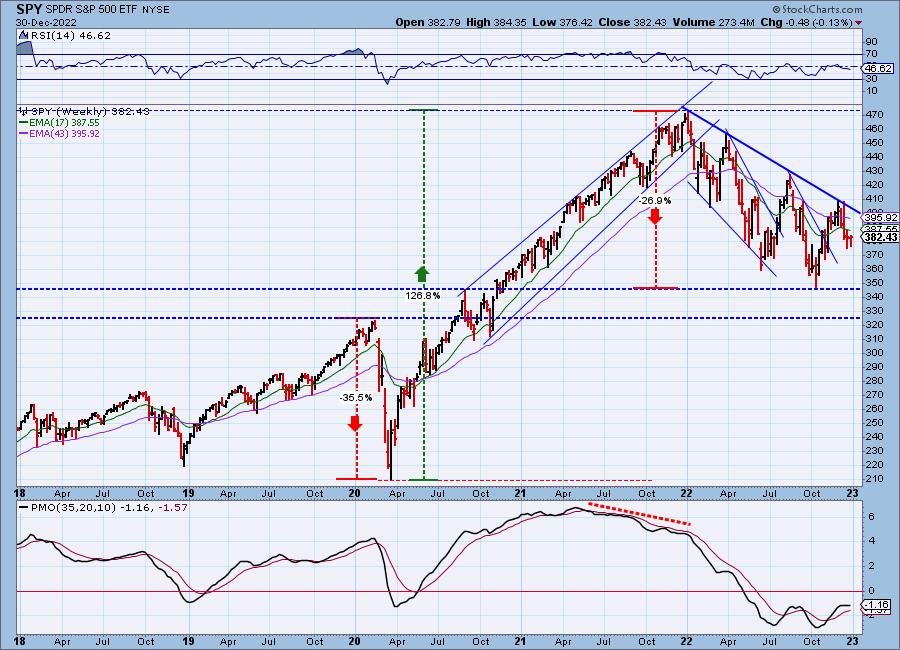
SPY Monthly Chart: We are still technically following a secular bull market rising trend and we note that support is holding at $350 with another line of support available at $325. However, with the monthly PMO traveling lower, in fact, accelerating lower and a negative monthly RSI, we believe that price will ultimately test the $325 level.
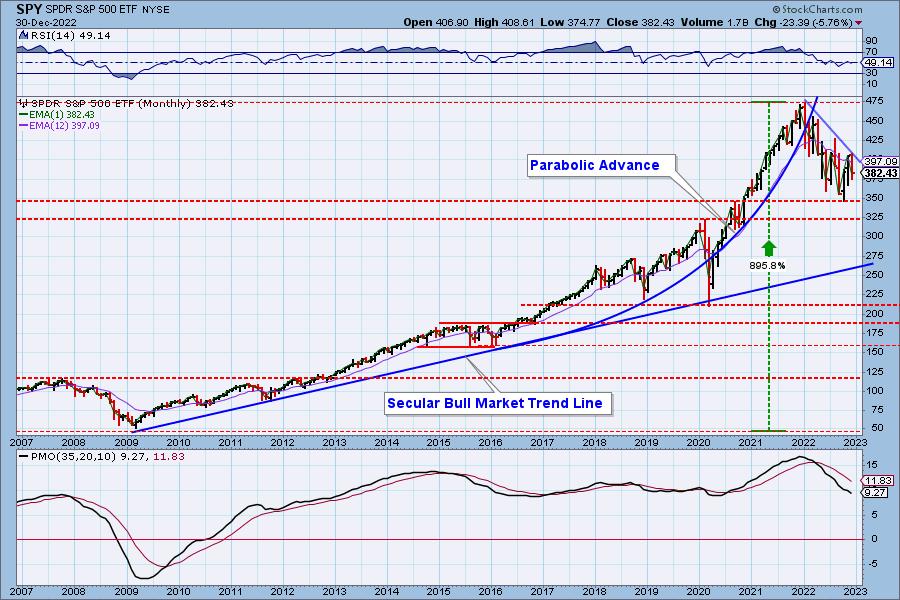
New 52-Week Highs/Lows: New Highs and New Lows were mostly negligible this week. Our primary concern is the falling 10-DMA of the High-Low Differential.
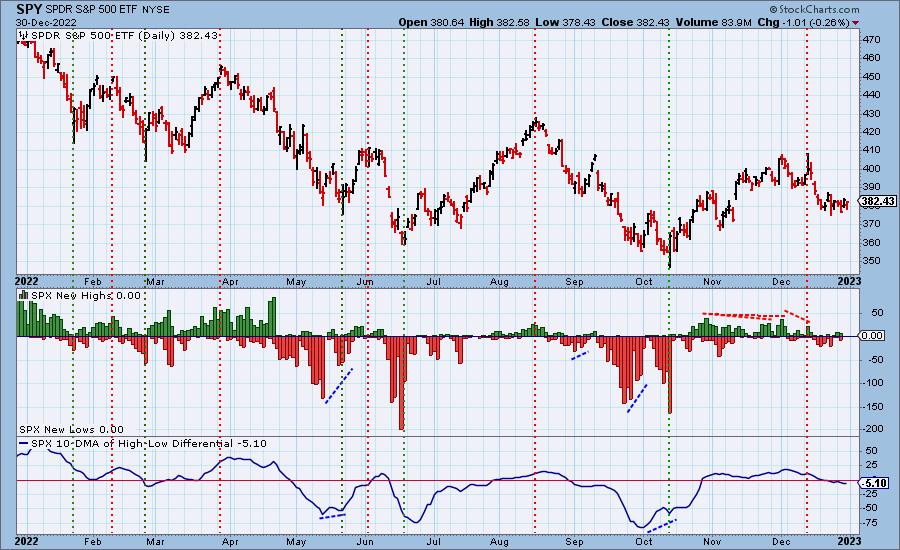
Climax Analysis: There were no climax readings Friday. We did see two climaxes this past week. A downside exhaustion climax on Wednesday and an upside initiation climax Thursday. We should have seen some upside follow-through and we didn't.
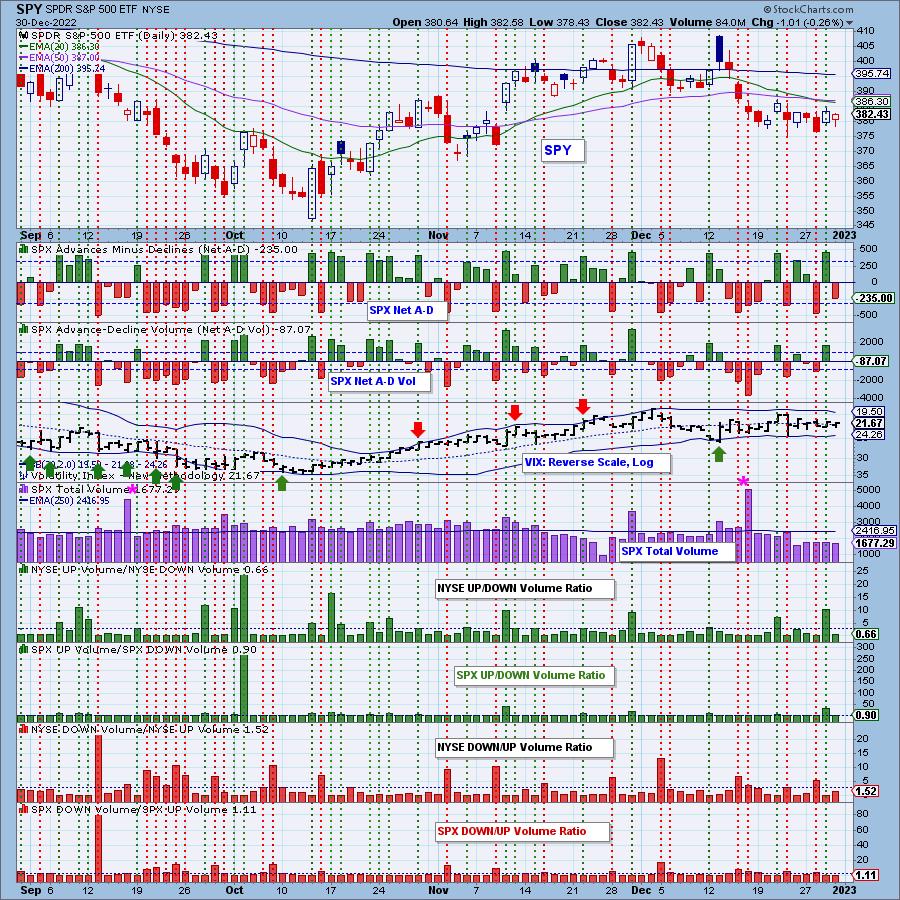
*A climax is a one-day event when market action generates very high readings in, primarily, breadth and volume indicators. We also include the VIX, watching for it to penetrate outside the Bollinger Band envelope. The vertical dotted lines mark climax days -- red for downside climaxes, and green for upside. Climaxes are at their core exhaustion events; however, at price pivots they may be initiating a change of trend.
Short-Term Market Indicators: The short-term market trend is DOWN and the condition is NEUTRAL.
On the bright side, STOs continue to move slightly higher. They remain in dangerous neutral territory where they are vulnerable to a downside reversal. Participation is still low given only 28% of the index are carrying rising momentum.
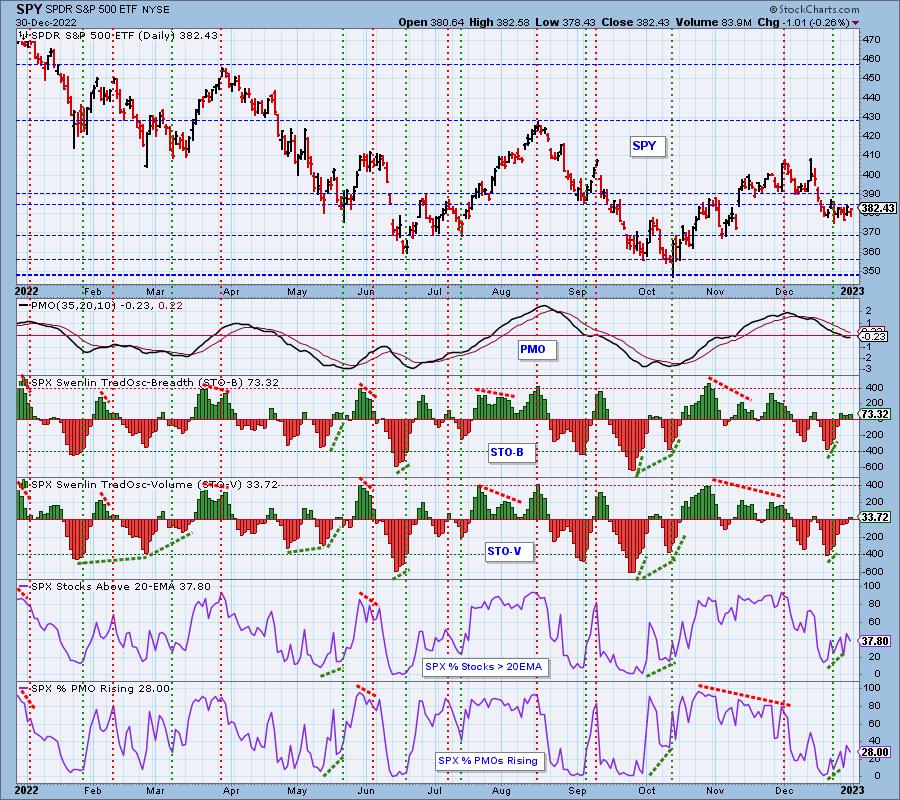
Intermediate-Term Market Indicators: The intermediate-term market trend is DOWN and the condition is NEUTRAL to OVERSOLD.
Technically, the ITBM and ITVM are rising, but barely. Not enough for us to consider this as a confirmation of rising STOs. We did see some improvement in the number of PMO BUY signals, but the percentage only improved by 5% this week.
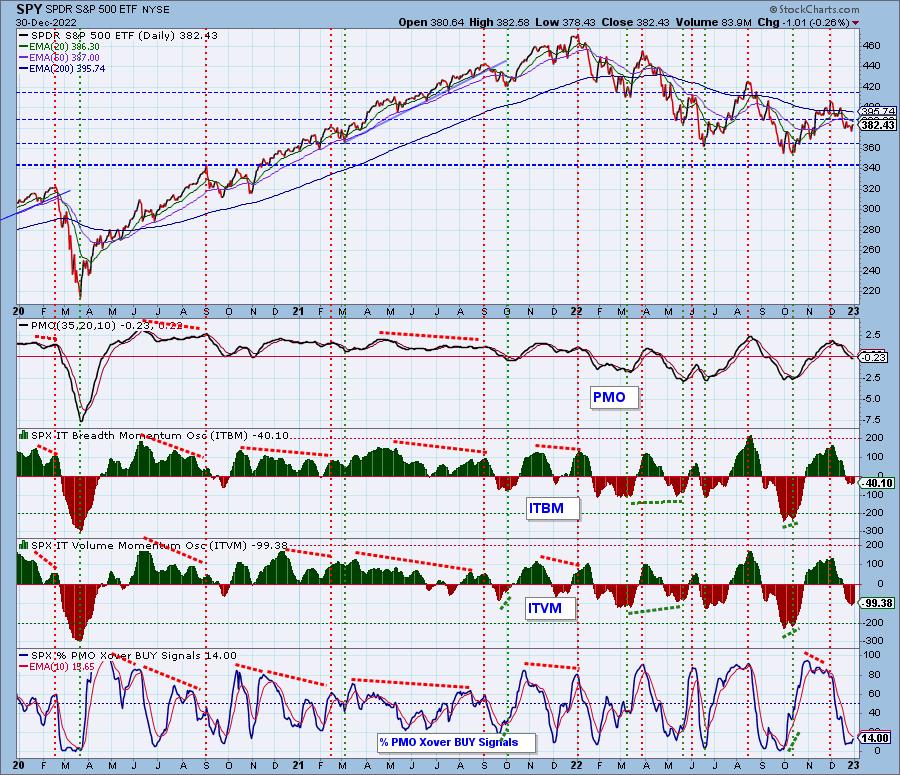
_______
PARTICIPATION and BIAS Assessment: The following table objectively shows the depth and trend of participation in two time frames.
- Intermediate-Term - the Silver Cross Index (SCI) shows the percentage of SPX stocks on IT Trend Model BUY signals (20-EMA > 50-EMA). The opposite of the Silver Cross is a "Dark Cross" -- those stocks are, at the very least, in a correction.
- Long-Term - the Golden Cross Index (GCI) shows the percentage of SPX stocks on LT Trend Model BUY signals (50-EMA > 200-EMA). The opposite of a Golden Cross is the "Death Cross" -- those stocks are in a bear market.
The following table summarizes participation for the major market indexes and sectors. The 1-Week Change columns inject a dynamic aspect to the presentation.
The most negative IT Bias belongs to XLE. This is primarily a function of having 100% of the sector on LT Trend Model BUY signals. We can see that the SCI did improve on XLE this week.
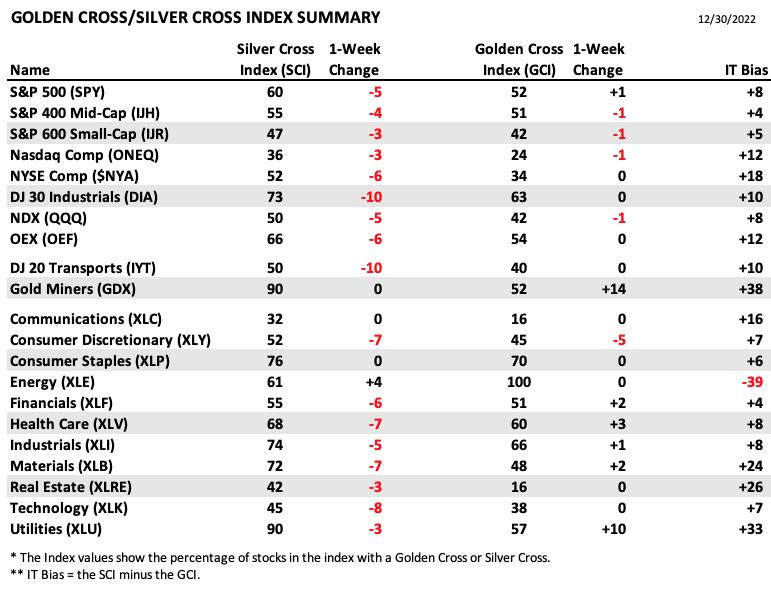
This table is sorted by SCI values. This gives a clear picture of strongest to weakest index/sector in terms of intermediate-term participation.
Gold Miners hold the strength, but Utilities (XLU) aren't far behind. The difference is XLU is deteriorating (down -3 on its SCI) and GDX is not.
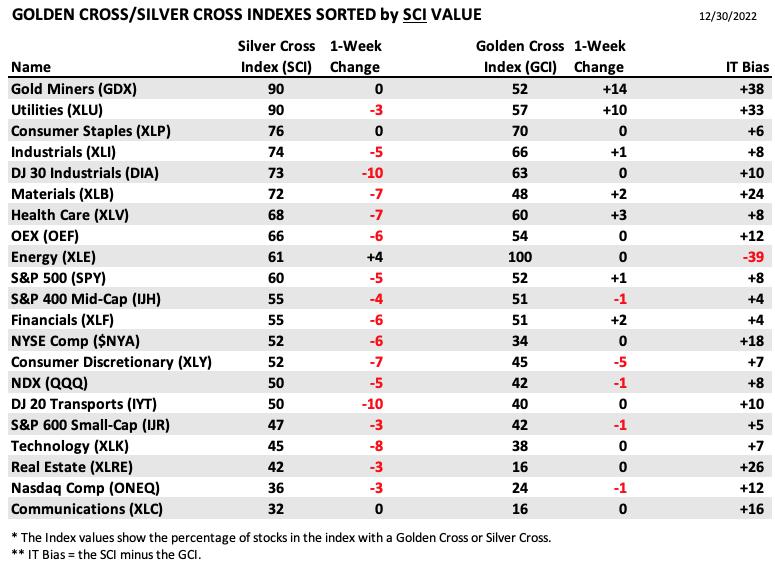
This table is sorted by GCI values. This gives a clear picture of strongest to weakest index/sector in terms of long-term participation.
While XLE holds the most negative IT bias, it clearly has a bullish long-term bias given 100% have Golden Crosses. Consumer Staples (XLP) has the next best GCI value, but remains stagnant in the intermediate term given no improvement was seen on its SCI.
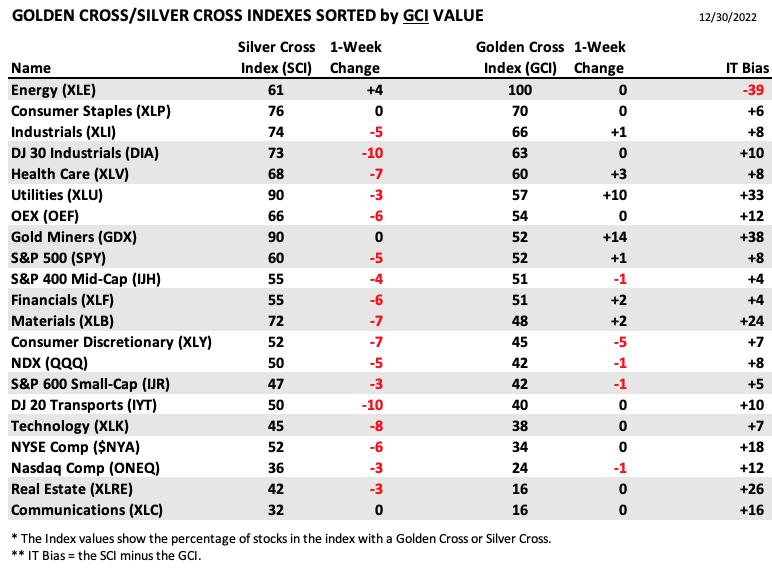
The following chart objectively shows the depth and trend of participation in three time frames.
This week, the market bias is NEUTRAL.
The short-term bias is BEARISH.
The intermediate-term bias is BEARISH.
The long-term bias is NEUTRAL.
We saw some improvement in the participation of stocks above their 20/50-day EMAs, but not enough to overcome the SCI reading. This means the SCI will likely continue lower. While the GCI is rising, the fuel to keep that going is dissipating. We have fewer stocks above their 50-day EMAs than Golden Crosses. Eventually the GCI will succumb, particularly if we start seeing fewer stocks above their 200-day EMAs. Currently the percentage above the 200-day EMA is equal to the percentage of Golden Crosses.
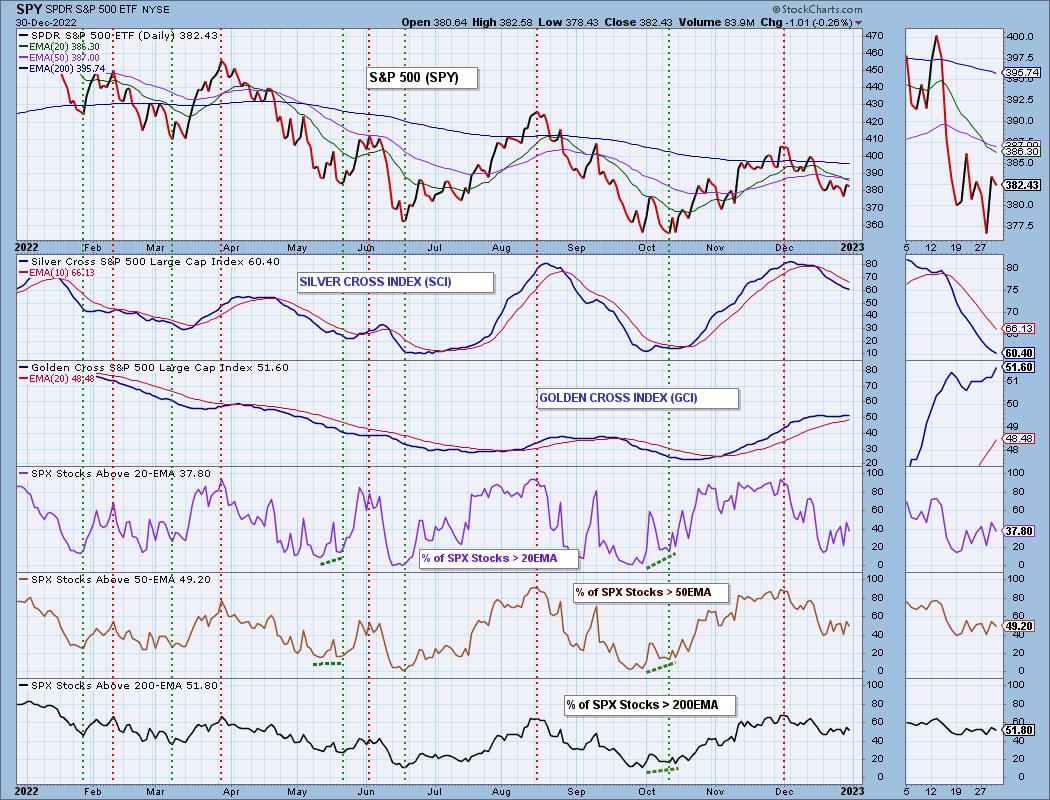
CONCLUSION: We saw a few bullish signs pop up this week that would normally mean positive price movement. We saw a few positive divergences and the ST and IT indicators turned up. We even had sentiment and seasonality on the market's side, but it wasn't enough to spark an end of year rally. It was enough to prevent more downside. Now we'll be losing seasonality and the market is weak. We are preparing for at best chop and churn and at worst a sizable decline. Expanding exposure could be dangerous. All positions should be managed in the short term.
Erin is 12% exposed with a 2% hedge.
Have you subscribed the DecisionPoint Diamonds yet? DP does the work for you by providing handpicked stocks/ETFs from exclusive DP scans! Add it with a discount! Contact support@decisionpoint.com for more information!
BITCOIN
Bitcoin had a rough week but managed to hold onto support at the December low. The PMO is useless as it is flat and unresponsive. The RSI is negative. Stochastics may be rising but they are in deeply negative territory below net neutral (50). Bitcoin will likely be lucky to hold current support.
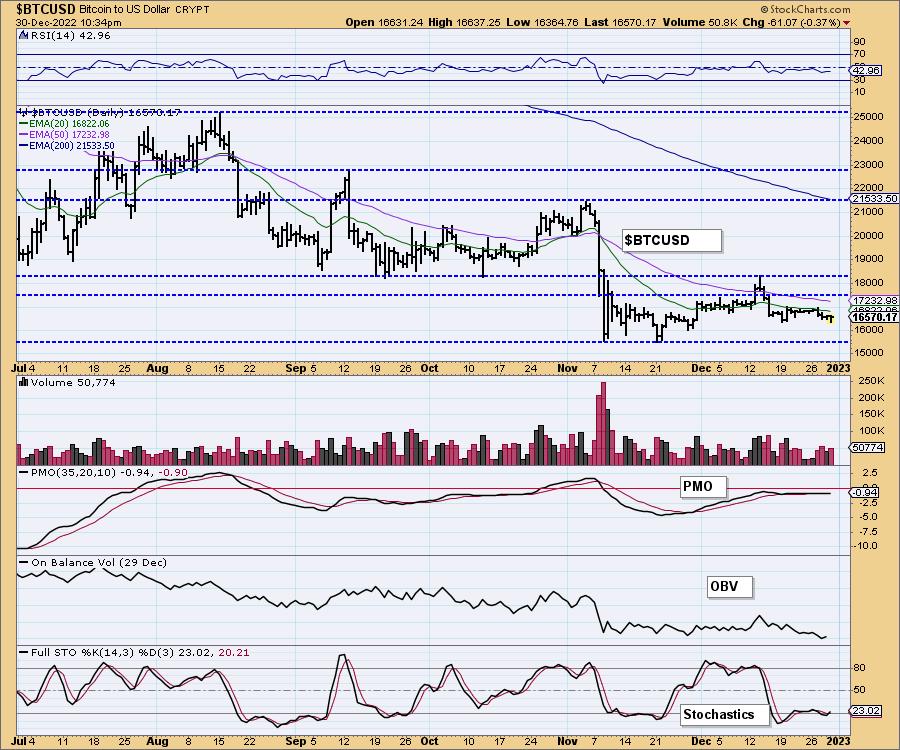
This chart is to show where some of the support/resistance lines come from.
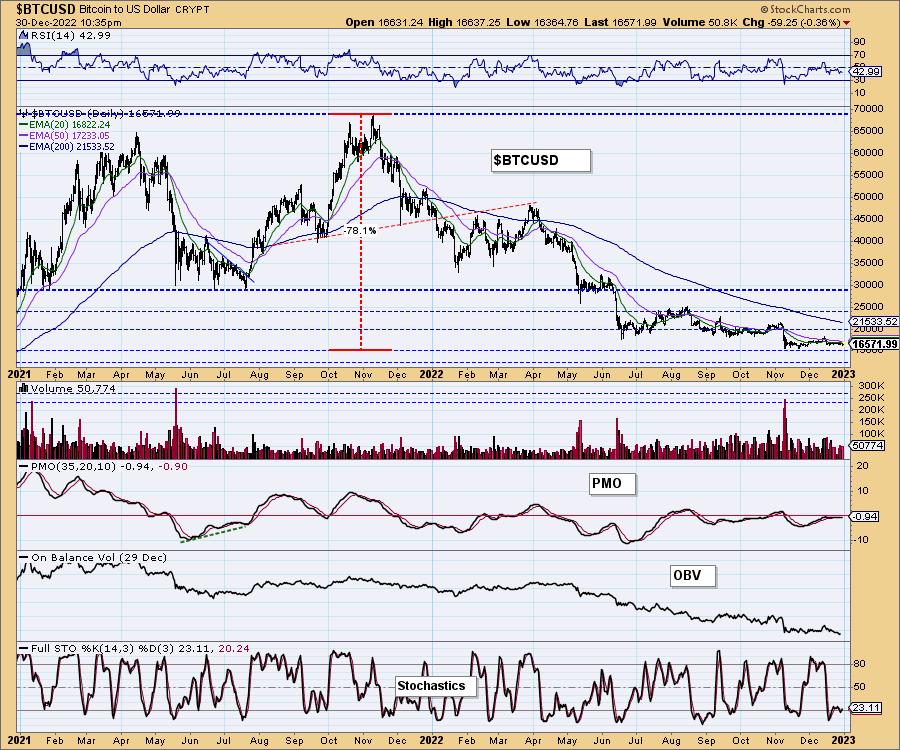
INTEREST RATES
Interest rates continued their rise this week with most getting ready to test November highs.
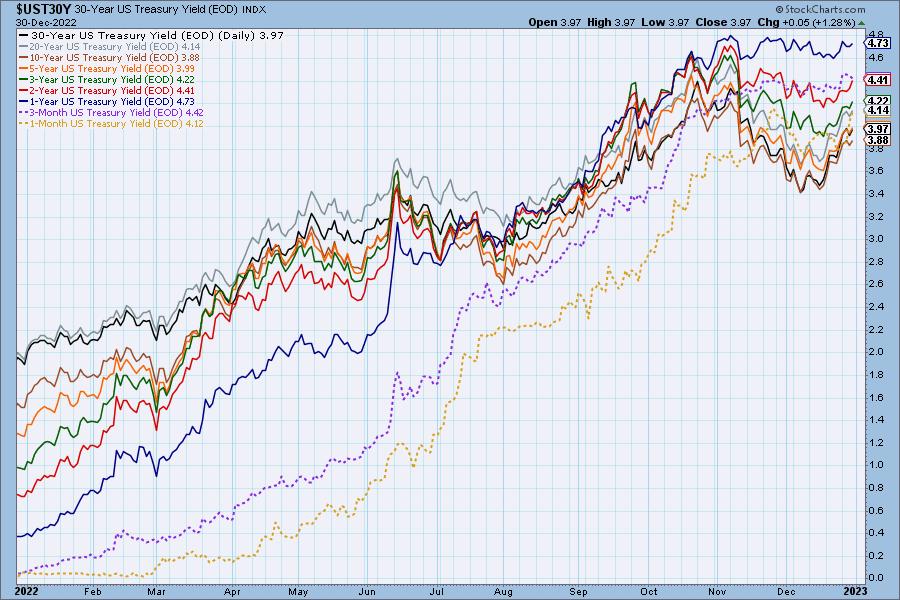
The Yield Curve Chart from StockCharts.com shows us the inversions taking place. The red line should move higher from left to right. Inversions are occurring where it moves downward.
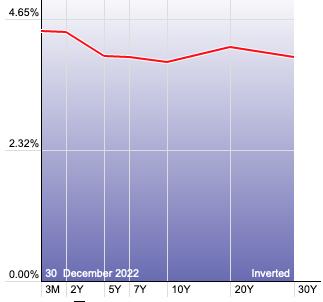
10-YEAR T-BOND YIELD
$TNX broke its intermediate-term declining trend after bouncing off support at 3.4%. Indicators are very positive with the PMO now in positive territory and both Stochastics and the RSI in positive territory. We don't think the rally in interest rates is over.
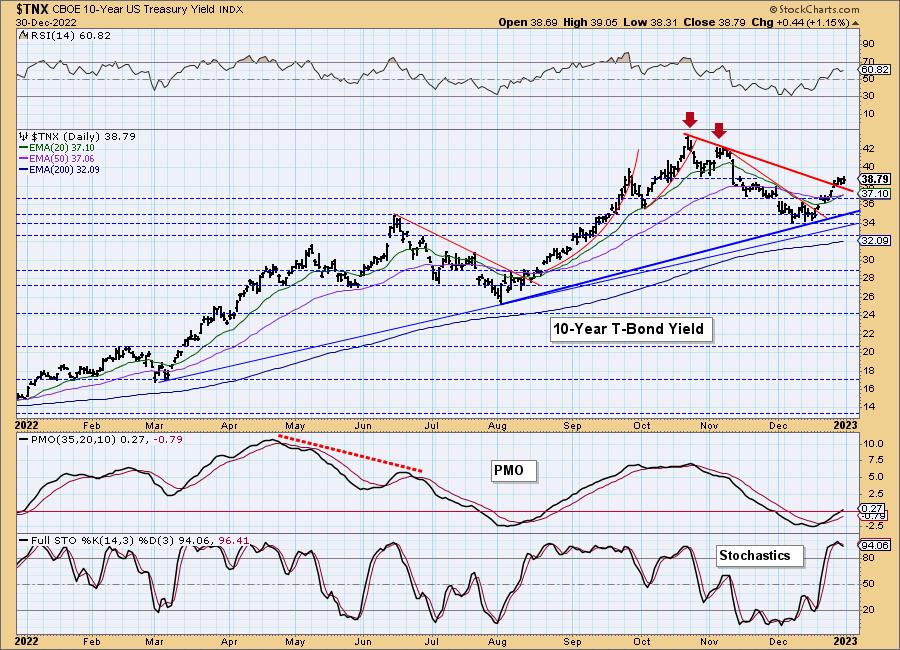
MORTGAGE INTEREST RATES (30-Yr)**
**We watch the 30-Year Fixed Mortgage Interest Rate, because, for the most part, people buy homes based upon the maximum monthly payment they can afford. As rates rise, a fixed monthly payment will carry a smaller mortgage amount. As buying power has been shrinking, home prices have come under pressure.
--
This week the 30-Year Fixed Rate rose from 6.27 to 6.42.
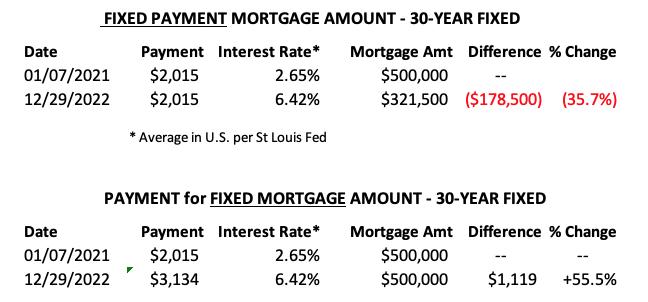

DOLLAR (UUP)
IT Trend Model: NEUTRAL as of 11/14/2022
LT Trend Model: BUY as of 8/19/2021
UUP Daily Chart: The Dollar flirted with a breakout from the declining trend on Wednesday, but resumed the decline shortly thereafter. The RSI is negative and the PMO is flat. Stochastics, which we consider an early warning indicator, have turned down and are back in negative territory.
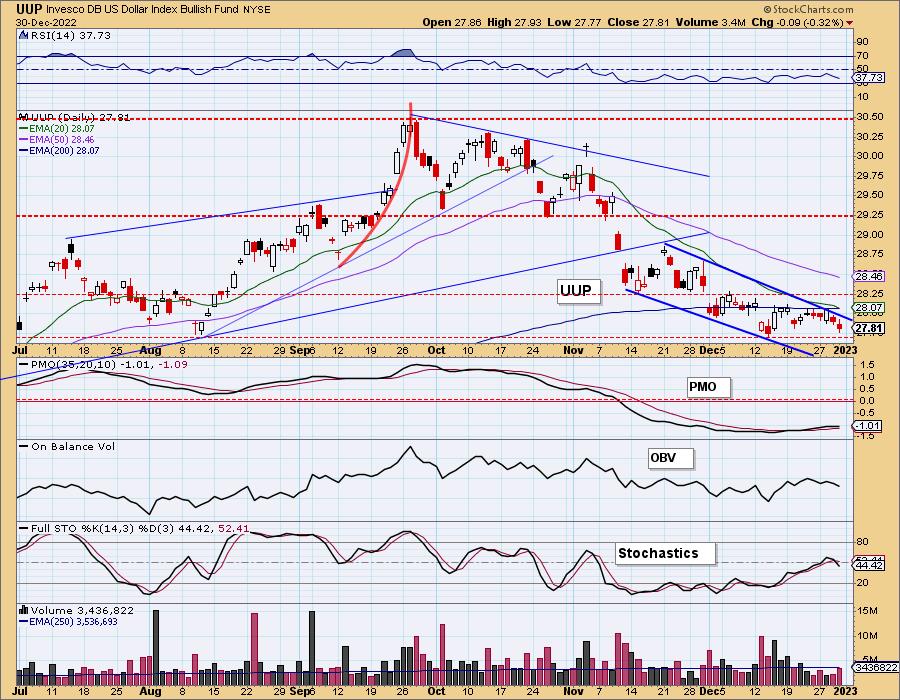
Longer-term support is arriving at the August low.
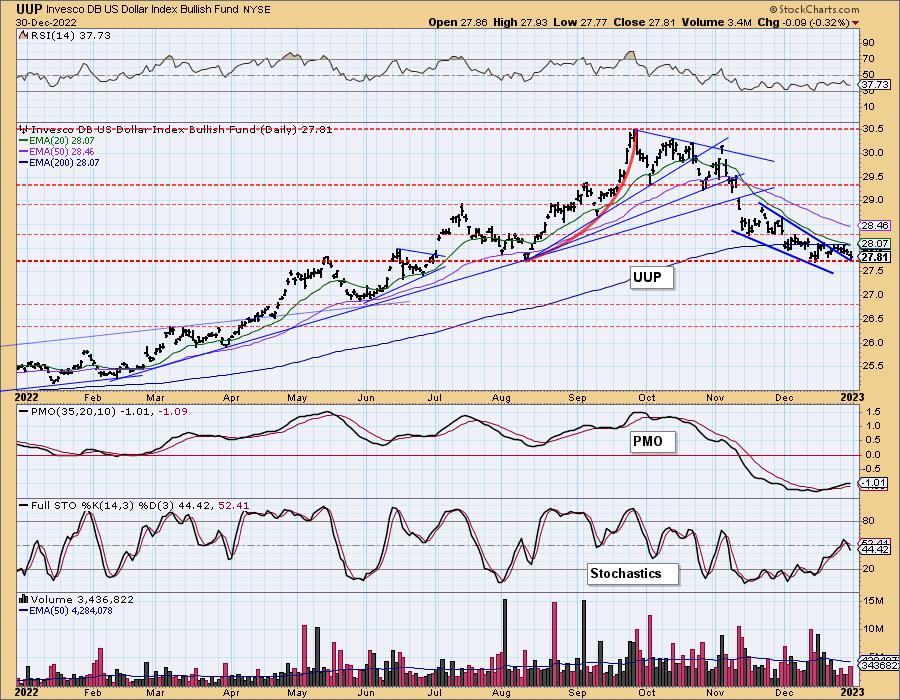
UUP Weekly Chart: Price plummeted after rising parabolically. Price has now dropped below the 43-week EMA. The weekly RSI is negative and falling and the weekly PMO couldn't get much more negative as it tumbles vertically lower.
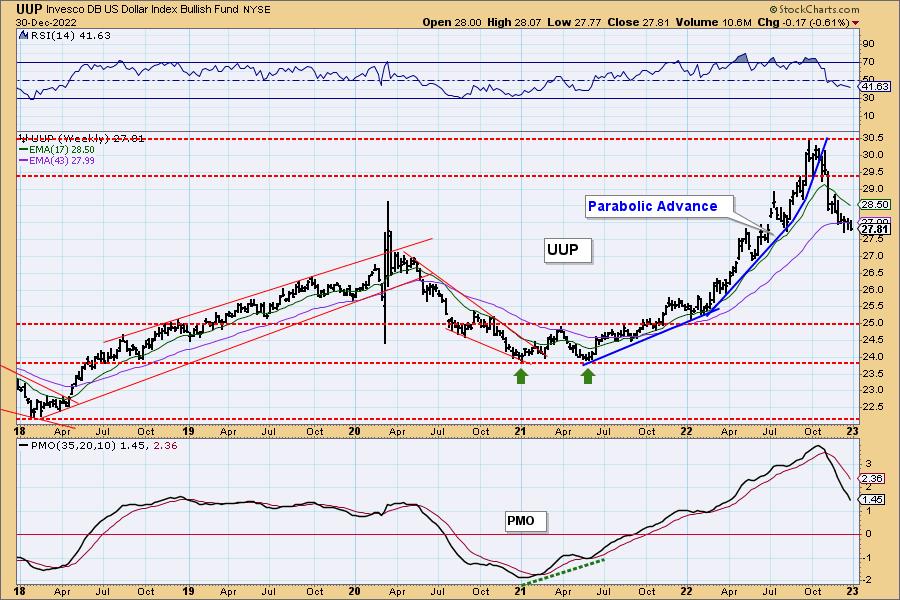
UUP Monthly Chart: The monthly PMO has topped in overbought territory. Overall we see a bearish bias on the Dollar and should expect to see lower prices in January.
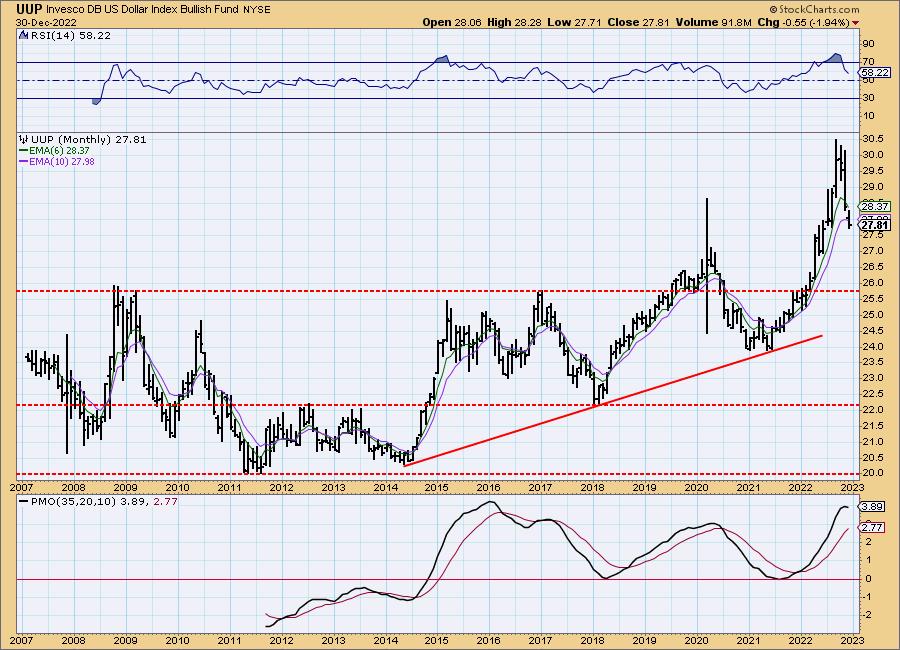
GOLD
IT Trend Model: BUY as of 11/14/2022
LT Trend Model: SELL as of 6/30/2022
GOLD Daily Chart: Gold is traveling in a bearish rising wedge both in the short and intermediate terms. The rising trend should be broken, but indicators just don't look that bad.
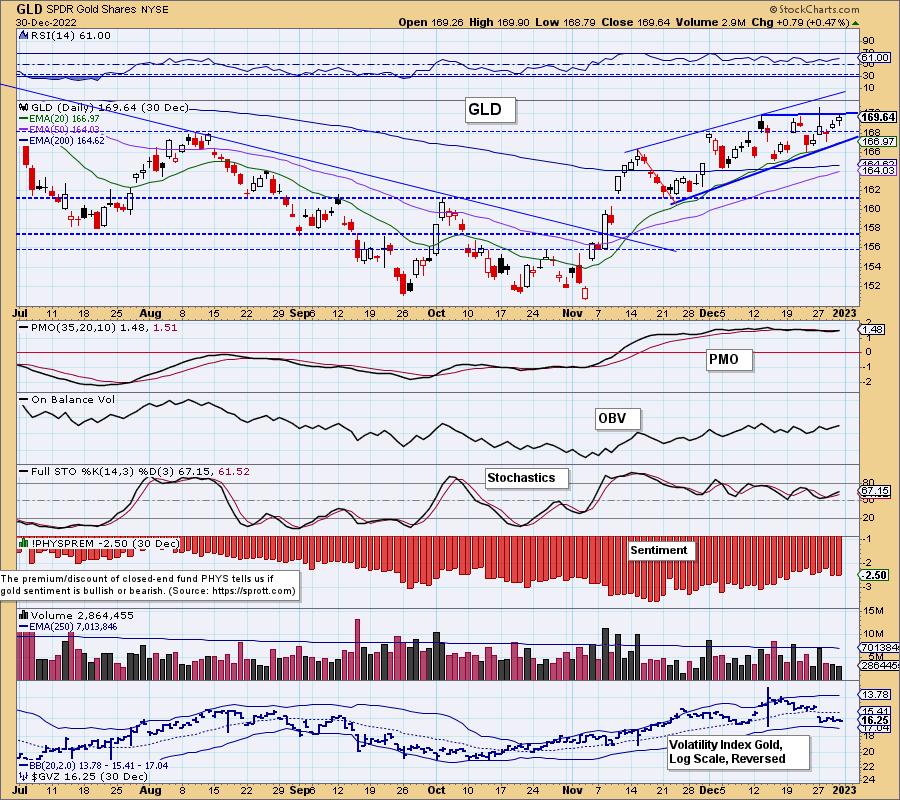
The PMO is flat but only five hundredths of a point away from another crossover BUY signal. The RSI is positive and Stochastics, while not oscillating above 80, are oscillating above net neutral (50). $GVZ is oscillating in negative territory so weakness is visible. Discounts were slightly higher on the week and sit in historically high territory suggesting investors are still quite bearish on Gold. Sentiment being contrarian, it could work in Gold's favor.
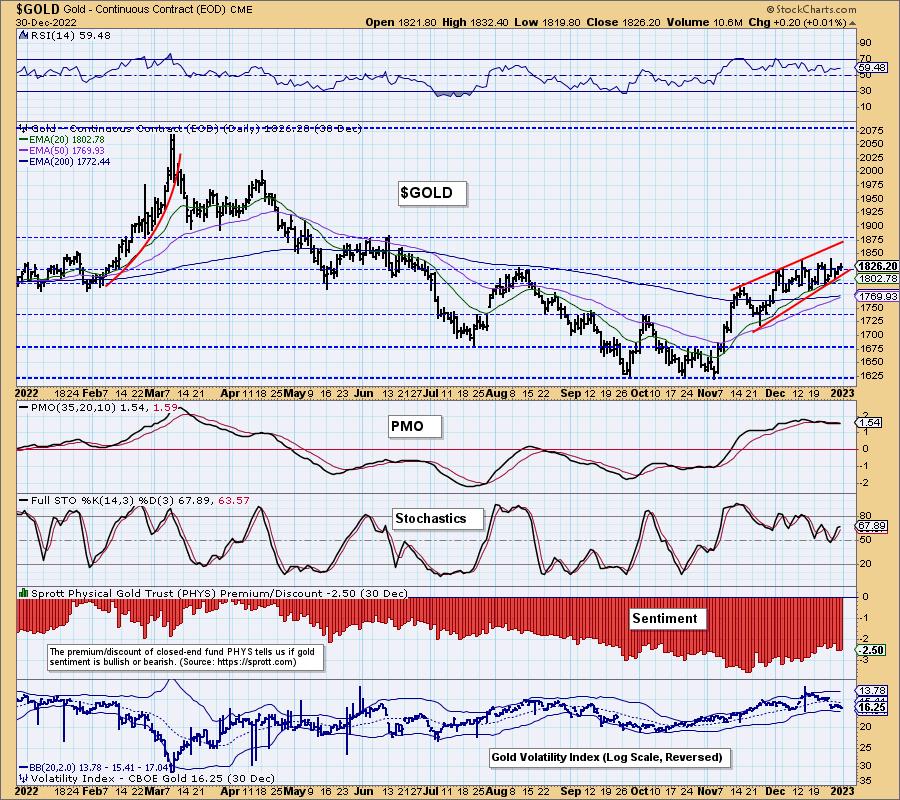
GOLD Weekly Chart: The weekly chart for Gold is bullish. The weekly RSI is positive and the weekly PMO is rising. On a weekly basis, discounts are paring back which suggests in the big picture, traders are slowly beginning to eye the metal.
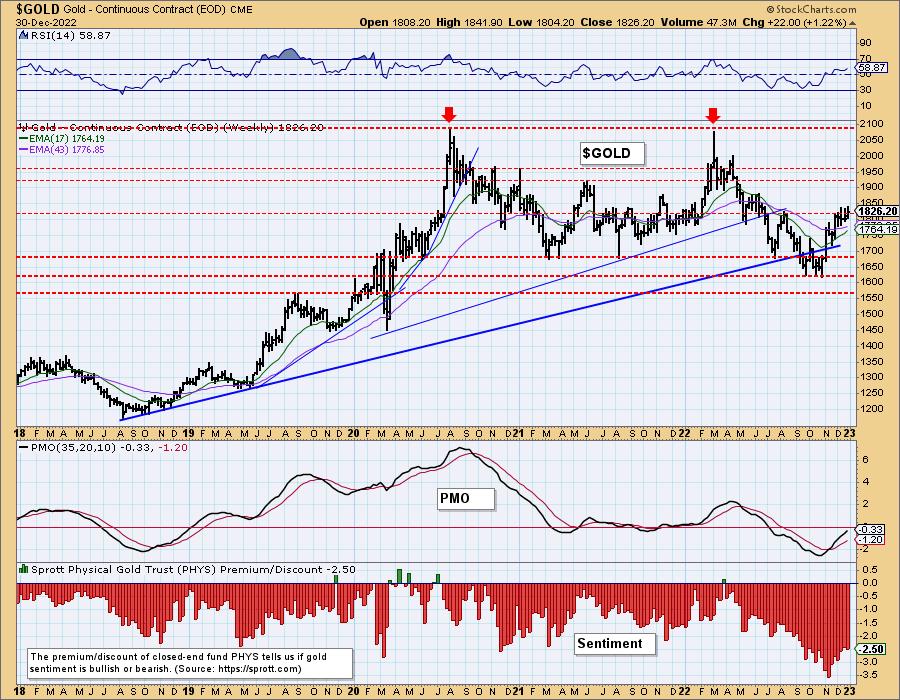
GOLD Monthly Chart: We're happy to see the monthly RSI back in positive territory and the monthly PMO beginning to rise. We are bullish in the long term on Gold and see promise going into next week and next month despite the bearish rising wedge on the daily chart.
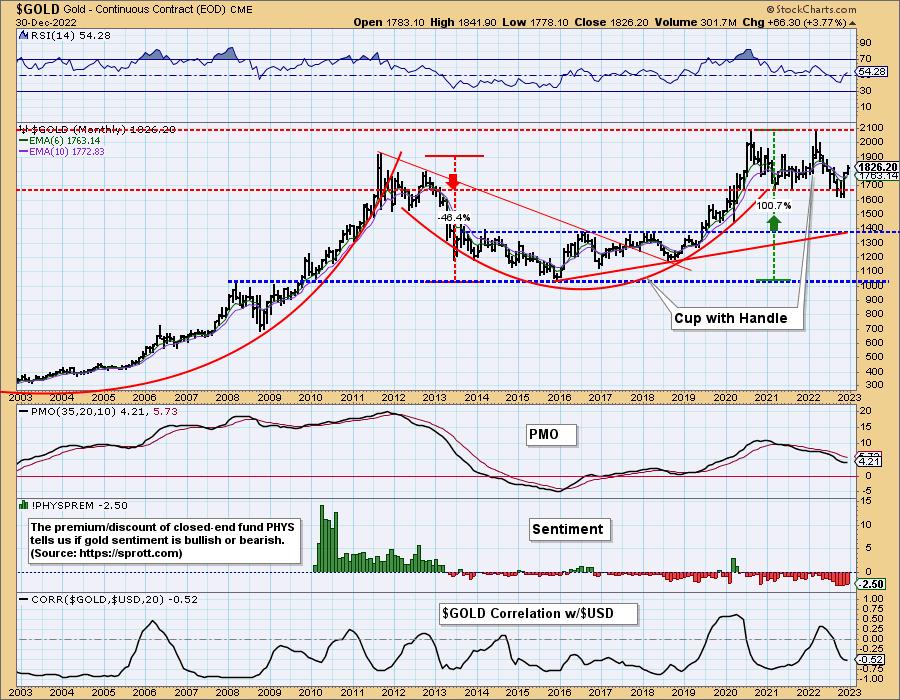
GOLD MINERS Golden and Silver Cross Indexes: If Gold improves and the Dollar continues to trend lower, Gold Miners will be in a good position. Right now they are looking shaky. The RSI is still positive, but the PMO is losing ground even if price isn't. Participation is beginning to thin compared to last week. While we could see holding GDX for now, this seems a precarious place to enter now.
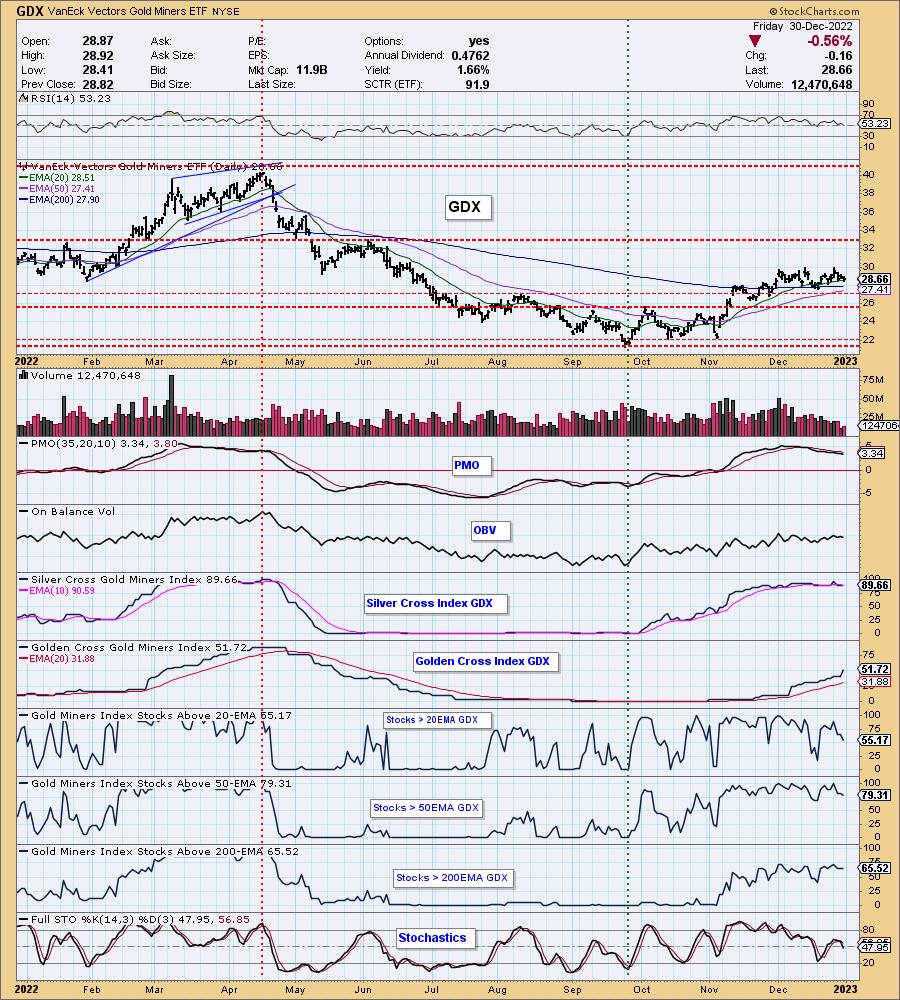
CRUDE OIL (USO)
IT Trend Model: NEUTRAL as of 11/21/2022
LT Trend Model: SELL as of 12/6/2022
USO Daily Chart: Crude Oil finished the week higher but it was a rocky road to get there. We still have a short-term rising trend that is intact along with a positive RSI. We like the look of both the PMO and Stochastics. We would definitely like to see confirmation that this rally will continue and a move above the 200-day EMA would do just that.
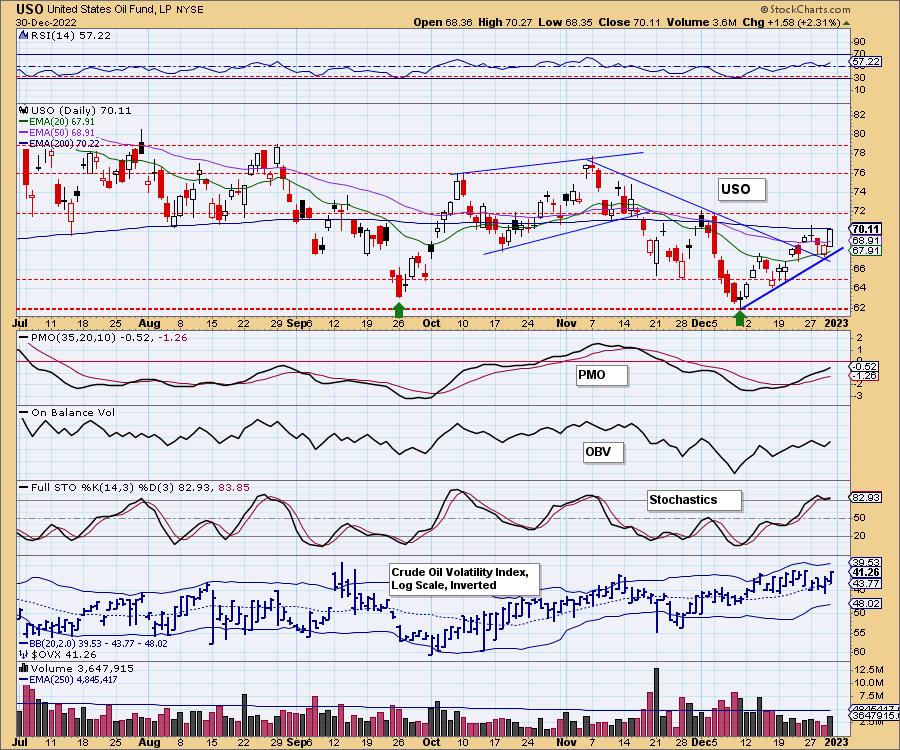
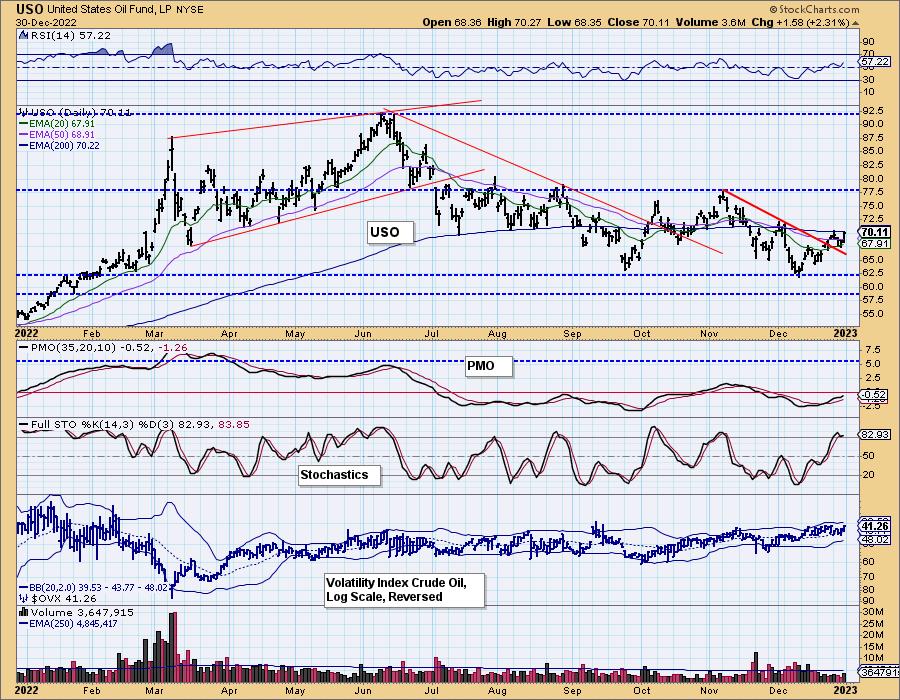
USO/$WTIC Weekly Chart: USO managed to preserve the long-term rising trend, but price is struggling against the 17/43-week EMAs. On the bright side, the weekly PMO is attempting to bottom above the zero line.
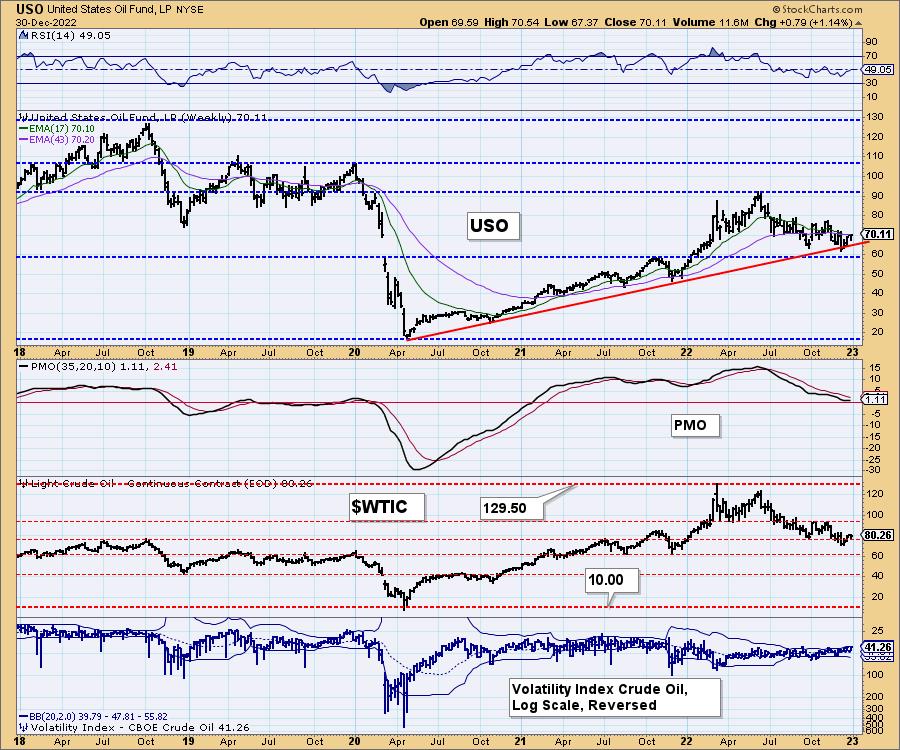
WTIC Monthly Chart: The long-term support level in 2018 has not held, but price is working its way back above it. However, the monthly PMO had a negative crossover, generating a SELL signal in the long term. The monthly RSI is positive, but we need to see support at $75/barrel to firm up.
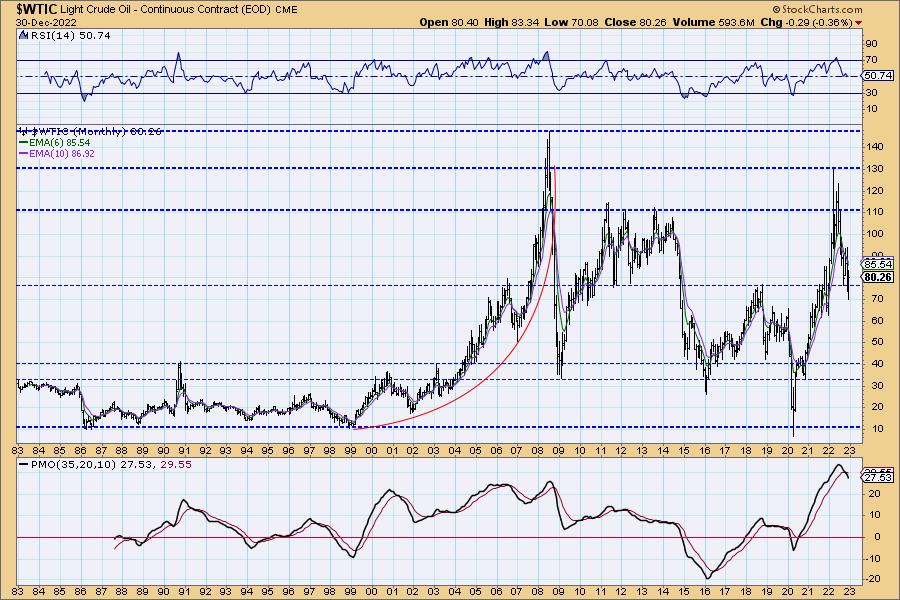
BONDS (TLT)
IT Trend Model: BUYas of 12/2/2022
LT Trend Model: SELL as of 1/19/2022
TLT Daily Chart: Despite the rally on the 20-year yield, TLT is clinging to support. We expect support to give way next week given the negative RSI and falling PMO. Mainly we expect support to give way because interest rates are looking too bullish to stop their march higher.
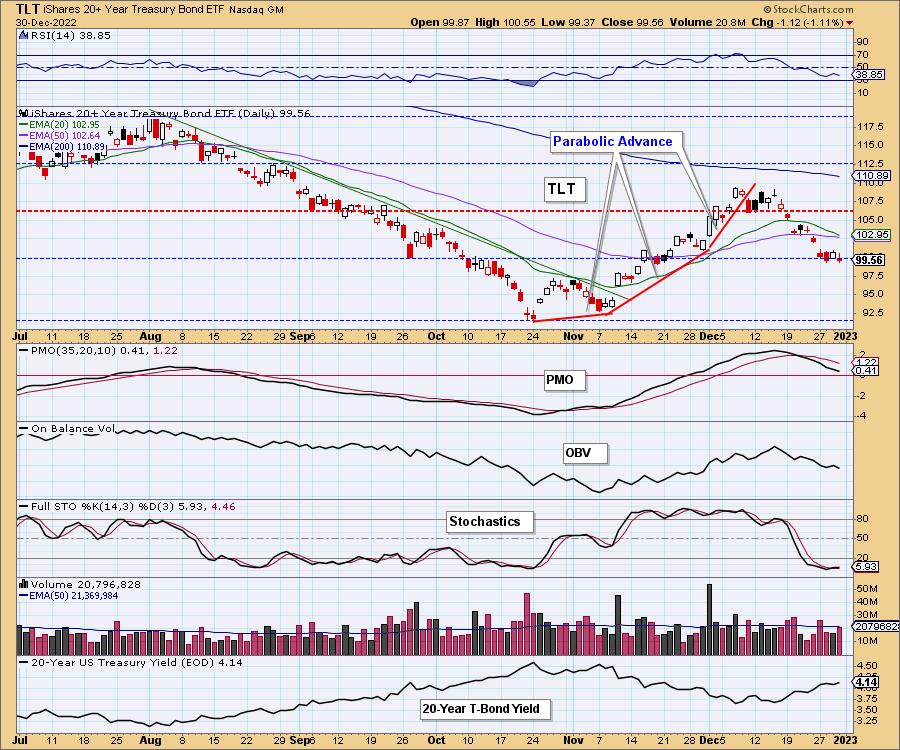
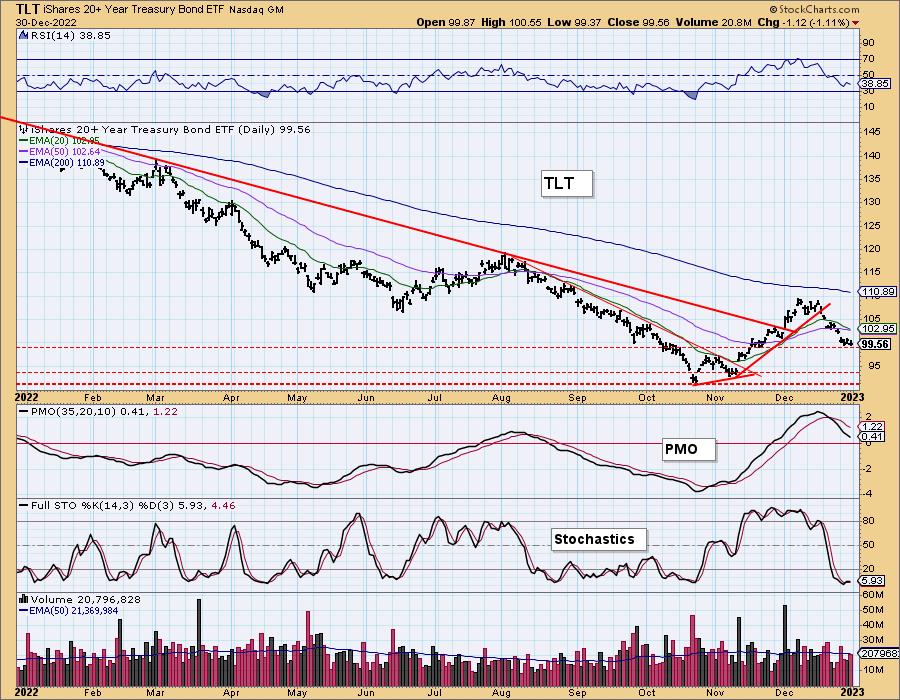
TLT Weekly Chart: The drop this week looks especially perilous as long-term support at the 2018 low was decisively broken on a gap down. The weekly RSI is negative and falling. The weekly PMO is slow to react, but is in the process of topping.
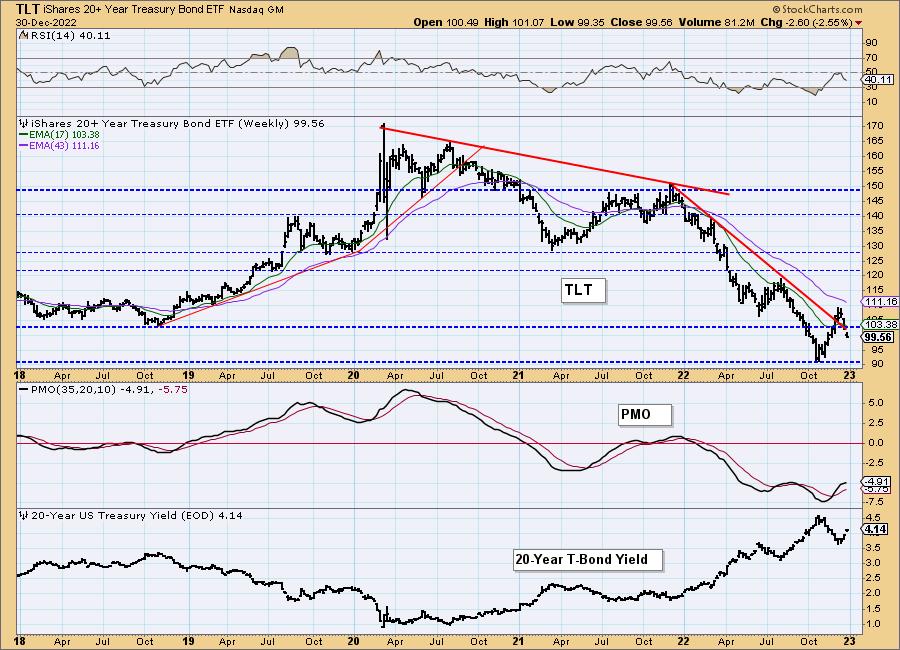
TLT Monthly Chart: The long-term picture doesn't improve with the monthly chart. The monthly RSI is very negative and the monthly PMO is in free fall well into negative territory. Price had just overcome resistance at the 2016/2018 lows last month, but fell back below this month. At a minimum we see TLT hitting $90 again.

Good Luck & Good Trading!
Erin Swenlin And Carl Swenlin
Technical Analysis is a windsock, not a crystal ball. --Carl Swenlin
(c) Copyright 2022 DecisionPoint.com
Disclaimer: This blog is for educational purposes only and should not be construed as financial advice. The ideas and strategies should never be used without first assessing your own personal and financial situation, or without consulting a financial professional. Any opinions expressed herein are solely those of the author, and do not in any way represent the views or opinions of any other person or entity.
NOTE: The signal status reported herein is based upon mechanical trading model signals, specifically, the DecisionPoint Trend Model. They define the implied bias of the price index based upon moving average relationships, but they do not necessarily call for a specific action. They are information flags that should prompt chart review. Further, they do not call for continuous buying or selling during the life of the signal. For example, a BUY signal will probably (but not necessarily) return the best results if action is taken soon after the signal is generated. Additional opportunities for buying may be found as price zigzags higher, but the trader must look for optimum entry points. Conversely, exit points to preserve gains (or minimize losses) may be evident before the model mechanically closes the signal.
Helpful DecisionPoint Links:
DecisionPoint Alert Chart List
DecisionPoint Golden Cross/Silver Cross Index Chart List
DecisionPoint Sector Chart List
Price Momentum Oscillator (PMO)
Swenlin Trading Oscillators (STO-B and STO-V)
DecisionPoint is not a registered investment advisor. Investment and trading decisions are solely your responsibility. DecisionPoint newsletters, blogs or website materials should NOT be interpreted as a recommendation or solicitation to buy or sell any security or to take any specific action.
